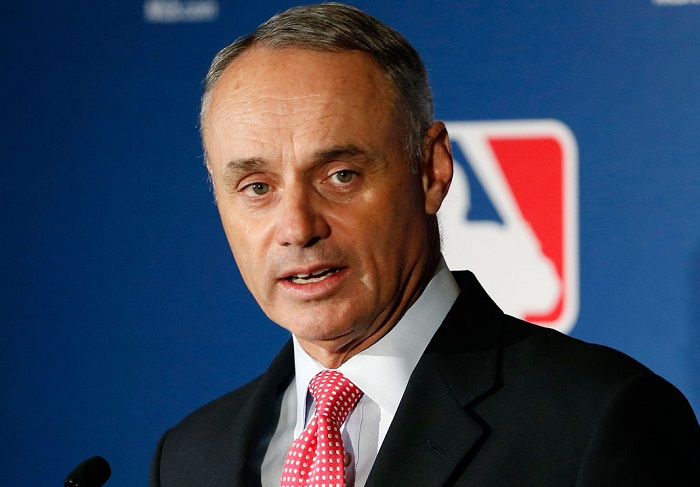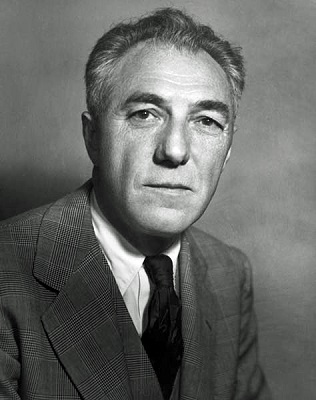While much of the baseball world is holding its collective breath over where Japanese phenom Shohei Ohtani and 2017 NL MVP Giancarlo Stanton will eventually end up, there is another hot topic that has, for the most part, remained under the radar for the past four months.
Expansion.
During a dinner meeting with baseball writers at this year’s All-Star break in Miami, MLB commissioner Rob Manfred told baseball’s most prominent writers of his desire to expand the current 30-team format to 32-teams.

According to Commissioner Rob Manfred, we may soon see two additional teams in Major League Baseball. (AP Photo)
But for as quickly as MLB’s top executive got the juices flowing for those on hand at the July 10 meeting, he immediately pointed out that there were a couple more pressing issues that needed to be resolved before any serious talks of expansion were put before MLB owners and the MLB Players Association.
“Let me go back to a conversation we’ve had already. I think for us to expand we need to be resolved in Tampa and Oakland in terms of their stadium situations,” Manfred said. “As much as I hope that both Oakland and Tampa will get stadiums, I think it would be difficult to convince the owners to go forward with an expansion until those situations are resolved.”
Manfred went so far as to name three possible candidate cities from where the two additional teams might come from.
“Once [Oakland and Tampa Bay are] done, I think we have some great candidates. I know the mayor of Montreal has been very vocal about bringing baseball back to Montreal. It was not great when the Expos left. The fact of the matter was baseball was successful in Montreal for a very long time. Charlotte is a possibility. And I would like to think that Mexico City or some place in Mexico would be another possibility.”
The commissioner also tossed Portland, Oregon out there as a possible candidate city as well.
That Mexico City thing is rather significant. As Dodger fans know, it was recently announced that the San Diego Padres will play host the Dodgers for a three-game series on May 4-6, 2018 at Estadio de Béisbol in Monterrey, Mexico. And even though the popular stadium has a seating capacity of only 26,999 (as opposed to… say… 27,000), you can bet that Manfred and the entire baseball world will be watching that one very closely to see the reception that it receives from the locals.
Following Manfred’s announcement to the baseball writers, Baseball America Spike award-winning writer Tracy Ringolsby came out with a rather comprehensive – if not controversial – expansion proposal that would see a 156-game schedule and would feature four eight-team divisions that include Manfred’s suggestion of the additions of Montreal and Portland:
- East: Atlanta, Baltimore, Cincinnati, Miami, Philadelphia, Pittsburgh, Tampa Bay and Washington.
- North: Boston, Cleveland, Detroit, Minnesota, Montreal, both New York franchises and Toronto.
- Midwest: Both Chicago franchises, Colorado, Houston, Kansas City, Milwaukee, St. Louis and Texas.
- West: Anaheim, Arizona, Los Angeles, Oakland, Portland, San Diego, San Francisco and Seattle.
Ringolsby took his proposal even further with several very specific key elements on how his expansion proposal might look:
- A 156-game schedule would include 24 total games against the eight teams in each of the three other divisions—three games against each opponent.
- The schedule would include 12 games—six home and six road—against each of the seven divisional opponents.
- The format would provide for an off day every week (such as every Monday or Thursday) and would fit into the same foot print for beginning and ending as the 2018 schedule. The season could start on a weekend, which would offset only one three-game series played the week of the All-Star Game.
- The 156-game schedule would reduce each team’s slate by six games, but revenue could be made up by a major reduction in travel costs.
- Fan interest could be maintained by allowing for the four first-place teams in each division to advance to the postseason, and having play-in games against the eight remaining teams with the best records.
- The winners of the four wild card games would advance to the Division Series, which would feature a wild card team against each division champion.
- Those four winners would advance to the Championship Series, and the winners of that round would meet in the World Series.
- That would add postseason product to the broadcast packages and provide postseason hope for 12 of the 32 franchises, which could boost attendance in September, again offsetting any impact from the season being six games shorter.
- With a day off every week, there would be a regular rest routine, much like prior to expansion when teams would often play Sunday doubleheaders and Monday would be off. It could be used for travel so teams did not have to make long flights, arriving in cities at 3 a.m. or later.
- And the schedule would drastically reduce travel, while keeping teams in their time zones, except for the Rockies and Twins. They, however, would be playing teams in a time zone an hour earlier, which is less demanding than an hour later, and also provides increased TV ratings because of prime time viewing. The other intra-division teams would have to travel to Colorado or Minnesota just six games per year.
- All teams would open the season with an inter-division series, and all out-of-division road trips would be two-city trips.
Whether or not Ringolsby’s proposal gains any momentum with Manfred and, more importantly, with MLB owners and the MLBPA remains to be seen. But it does create a bit of an enigma for longtime baseball purists, many of whom are still struggling with the asterisks that abound at the National Baseball Hall of Fame and Museum in Cooperstown, New York due to increasing the schedule from 154 games to 162 games in 1962 and the expansion from 28 teams to 30 teams in 1998 with the addition of the Tampa Bay (Devil) Rays and Arizona Diamondbacks.

The last time Major League Baseball changed the number of games played in a season was in 1962 when Ford C. Frick was commissioner. (AP Photo)
Would reducing the current schedule from 162 games to Ringolsby’s proposed 156 games now require two asterisks in the sacred Halls of Cooperstown for future MLB record-setters?
“I wouldn’t think so because the thing that’s not going to change is the field dimensions,” said longtime Dodgers historian Mark Langill. “It’s still the sixty-feet six-inches, the ninety feet and everything like that, so as long as they’re still playing similar rules.
“You could have said that question in 1962, ‘Should there be expansion?’ You could have said ‘Do we really need 162 games instead if 154?’ Walter O’Malley was asked when [the Dodgers] came out here in 1958 ‘Could the Los Angeles market support two teams?’ and he said ‘Well, it’s not for me to say, if the public wants it I’m not going to stand in the way,” Langill added.
The veteran Dodgers historian also said that he doesn’t see why Commissioner Manfred would stand in the way of expansion either.
“I don’t think that the commissioner would do something unless there was either a consensus or a reason to do it,” Langill said. “And so I think like anything, you have to look at this with an opened mind because it’s a sport that we all love and you want it to grow and you want it to become popular, and the last thing I would think anyone would want to do is say ‘But we’ve never done it that way before.’
“Look at all the things that are around here (at the Dodger Stadium) that have never been done that way before, starting with the renovations as far as the ballpark,” Langill continued. “Somebody might have looked at this ballpark 15 years ago and said ‘It’s old, it was built in 1962, they’ve got to get a new one.’ And Guggenheim comes and when does a 50-year-old ballpark get a hundred-million dollar face lift? And suddenly you see the over-sized bobbleheads and these places that people love to take Instagram pictures and Instagram photo spots and said ‘We’ve never done that before,’ then you wouldn’t have had progress.
“So some things change but then just like the ninth-inning of a tight ballgame or that feeling when a guy’s got a no-hitter in the eighth inning and you don’t want to interrupt your routine or whatever you’re doing at home, some things never change.”

“Can’t put me finger on what lies in store, but I feel what’s to happen all happened before.”
(‘Mary Poppins’ – 1964 – Click on image to view video clip)




 December 5th, 2017 at 8:00 am
December 5th, 2017 at 8:00 am  by Ron Cervenka
by Ron Cervenka  Posted in
Posted in 

That works for me. Rockies games are blacked out here, so there are 19 games I can’t watch live. This would cut it to 3. So, even though that would have 6 fewer games I’d be able to watch 10 more.
This is not figuring in national broadcasts, of course.
Generally I hate change, but I find that in almost anything, I get use to it. I even think that almost everything baseball has done, over the past 50 some odd years, have been for the better.